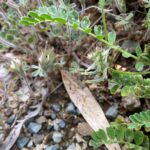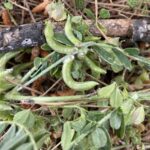Αστράγαλος ο αγκύλος
Etymology of Astragalus hamosus: The name of the genus, "Astragalus", comes from the Ancient Greek "ἀστράγαλος" [astraghalos], which means "cervical vertebra, earring, and wrist". It is a very old world, appearing in Herodotus, Theocritus, and even Homer. One theory suggests that the genus was named as such because of the shape of the seeds, which resembled the dice of an ancient game, made of knuckle-bones, which never had more than four flat sides. The second cervical vertebra of sheep was used as dice by the Ancient Greeks, after removing the posterior arches. Latin "hamosus" comes from "hamus'' (hook) and means "hooked, hooked at the tip", which refers to the appearance of the fruit hooked as a hook on the peduncle.
There are around 13 Astragalus taxa found in the wild Cypriot nature.
Astragalus hamosus is one of the commoner species of the genus in Cyprus. It exists possibly all around the island up to an altitude of 1150 metres. Its flowering period is between February and April.




